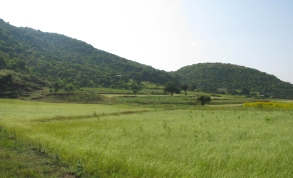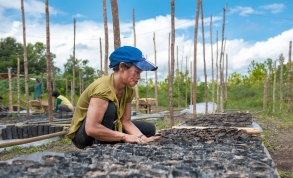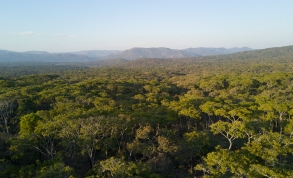Abstract
In the Humbo district in Ethiopia, poverty and hunger led to an overexploitation of forest resources. As a result, forests surrounding Humbo were largely destroyed by the 1960s. The Humbo Community-based Natural Regeneration Project, Ethiopia’s first carbon sequestration initiative, was implemented to reduce poverty and restore local ecosystem services. The project regenerates 2,724ha of degraded forests, gives local communities the opportunity to benefit from carbon markets and encourages communities to implement Farmer Managed Natural Regeneration (FMNR) techniques. Within the first year of the project, local farmers were able to harvest fodder and firewood and within the first three years, there was an increase in non-timber forest products such as wild berries, which helped diversify incomes; in addition to income generated from trading in certified emission reduction (CER) credits. Restoration of vegetation cover, diversification of income streams and creation of organisational management structures also enhanced climate change resilience, reduced flooding, landslides, soil erosion, and silt load improved agricultural productivity by reducing the risks associated with farming.
Intervention Overview
Poverty, hunger and increasing demand for agricultural land had driven local communities in Ethiopia to over-exploit forest resources - at the time of this project, Ethiopia had less than 4% of intact native forests. World Vision Ethiopia with support from World Vision Australia established the Humbo Community Managed Natural Regeneration project in the Humbo area in 2006 to jointly address the challenges of poverty alleviation and environmental restoration.
The intervention was a Community-based Natural Regeneration Project spanning over 2,724ha. Landscape regeneration was done primarily through Farmer Managed Natural Regeneration (FMNR), a systematic regeneration of native tree-stumps and shoots into fully grown trees by carefully integrating these trees into agricultural landscapes. It was also Ethiopia’s first carbon sequestration initiative to trade carbon credits through the World Bank under the Clean Development Mechanism (CDM). CDM is a United Nations-run carbon offset scheme allowing countries to fund greenhouse gas emissions-reducing projects in other countries and claim the saved emissions as part of their own efforts to meet international emissions targets.
This study reports on the progress of the Humbo project four years after its implementation. It is based on a desk study of key project documents and reports, personal communication with key informants and site visits by the authors. Given the early stage of the project in 2010 when the study was conducted, a quantitative assessment would have been premature.
Outcomes
At the time of the study in 2010, 2,724ha of degraded forest were protected and restored. The first carbon revenue of US$ 34,000 was received in 2010 and based on the emissions reduction agreement (ERPA), the project anticipated carbon revenues worth US$ 726,000 from the World Bank over the first ten years from the sequestration of 150,000 tons of CO2. Establishing forest cooperatives further helped to establish land user rights and manage forest revenues.
Within the first year of the project, local farmers were able to harvest fodder and firewood and within the first three years non-timber forest products and wild berries, providing income generation in addition to the carbon sequestration income. The community also reported less flooding.
After 36 months, the changes in vegetation were so pronounced that the celebration of Ethiopia’s national environment day celebration took place at the Humbo project site in 2009. Community members also noted an increase in biodiversity (wildlife and birds) in the surrounding forests.
Feasibility and potential impact of scale-up
The Humbo project seems to have succeeded where other community reforestation projects have faced challenges. Success can be attributed to natural regeneration which favours native/indigenous species and the mobilisation and empowerment of the local communities. World Vision Ethiopia worked with community members and government authorities to establish management structures, create bylaws and to build local capacity to lead and manage the activities. Previous efforts that applied conventional forestry practices (such as planting exotic species) were unsuccessful and led to poor survival rates. Too often, previous efforts were top down, and effectively excluded the communities in decision making processes and goal ownership. The Humbo project used a cooperative model to organise the community at grass root level to restrict access and unwise use of natural resources.
FMNR techniques have proved successful in the Sahel, for example in Niger, crop yields and fodder production increased after implementation. FMNR is easy to adopt and implement which supports scaling up: the knowledge and techniques were handed down from farmer to farmer without needing any external support or intervention. When applied in a resource-limited context FMNR can not only help to restore land but also be an important means to reduce poverty. No external inputs including pesticides or fertilisers are required which makes it inexpensive, easily replicable and provides noticeable short-term benefits.
Whilst in theory the CDM holds great potential, there are a few limitations, firstly, it is often difficult to estimate the future carbon sequestration potential for rural community projects during the initial implementation stages (Jindal et al., 2008). Whilst small-scale community projects often provide the largest and most direct benefits to communities, it is expensive to monitor the impact (Taiyab, 2006) which makes registration with CDM difficult. Moreover, purchasing emission offsets from low-income countries through the CDM can distract overall decarbonisation efforts; there is a risk that it shifts the responsibility from the biggest polluters (high-income countries) to the ones who are least polluting but are most affected by climate change impacts (low-income countries).
References
Academic profile / relevant organisation’s page
- Brown, D. R., Dettmann, P., Rinaudo, T., Tefera, H., & Tofu, A. (2011). Poverty alleviation and environmental restoration using the clean development mechanism: a case study from Humbo, Ethiopia. Environmental management, 48(2), 322-333. Available online: https://citeseerx.ist.psu.edu/viewdoc/download?doi=10.1.1.982.9737&rep=…
- Thiende B, 2014, Humbo Community Managed Natural Regeneration Forest Project: End of Project Report, Project Phase: Transition Phase
Supplementary information
- Jindal R., Swallow B., Kerr J. (2008). Forestry-based carbon sequestration projects in Africa: potential benefits and challenges. Natural Resources Forum 32:116–130. Available online: https://doi.org/10.1111/j.1477-8947.2008.00176.x
- Taayab, N.(2006). Exploring the market for voluntary carbon offsets. IIED, London. Available online: https://books.google.co.uk/books?hl=de&lr=&id=PJBDOIB3tNoC&oi=fnd&pg=PP…
Contact
- Kebede Regassa, World Vision Ethiopia, Email: [email protected]


